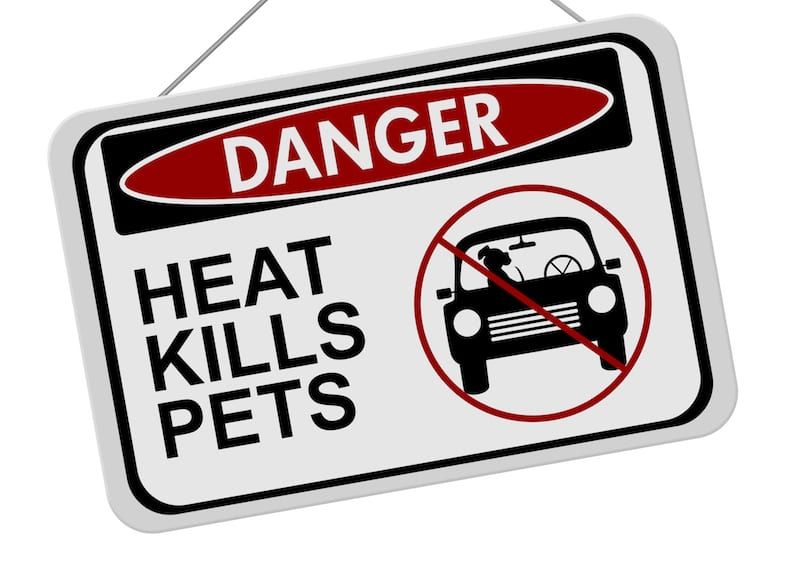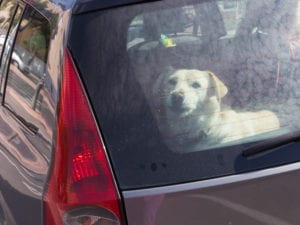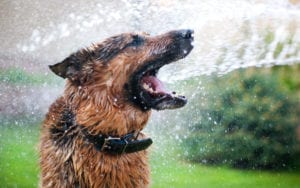
How to Identify Heat Stroke in Dogs & Cats & How To Save Pets with Heat Stroke
Heat stroke in dogs & cats is a deadly condition that’s totally preventable. Yet, year after year, stories of dogs or cats that died an agonizing death from being locked in a hot car continue to be reported.
National Pet Heat Awareness Day is May 25, 2018. In honor of that holiday, we offer reminders on never leaving your dog or cat in a car, how to spot signs of heat stroke in your pets & what to do to save their lives from this deadly condition.
Heat Stroke Prevention: Never Leave Your Pet in a Parked Car
 Many pet owners who leave their pets in the car say “It’s only for 5 minutes” or “It’s not that hot today.” This is a total myth.
Many pet owners who leave their pets in the car say “It’s only for 5 minutes” or “It’s not that hot today.” This is a total myth.
For starters, dogs are usually left in the car for more than “5 minutes.”
Even more important, the inside of a car reaches dangerous temperatures within MINUTES.
Heat Stroke Facts – Did You Know:
- At 70 degrees on a sunny day, the temperature inside a parked car rises to 104 degrees within 30 minutes.
- After an hour, the temperature reaches 113 degrees. – (Source: San Francisco State University Research Study)
- Even on a cool day, the temperature in a parked car will spike to life-threatening levels if the sun is out. Children and dogs have died in cars when outdoor temperatures were just 63 degrees. (Source: Stanford University Research Study)
- Leaving the windows cracked open does not reduce the heat inside the car.
The Temperature in a Parked Car Reaches Deadly Levels, Even on Cool Days – Stanford University Study
Everybody knows a car heats up fast on a hot day. The Stanford University School of Medicine took it step further and specifically studied how hot a car gets on a cool day.
Their findings showed:
- A parked car heats up by an average of 40 degrees within an hour, even on a comfortable, 70-degree day.
- 80% of the increase in temperature inside a parked car occurs during the first 30 minutes.
- The temperature inside a parked car rises at the same intensity with the windows fully closed or left open by a few inches. Leaving the windows cracked just a bit doesn’t bring the temperature down.
What is Heat Stroke in Dogs, Cats & Other Animals?
Heat stroke is a deadly condition that happens when a person or pet is exposed to excessive heat, humidity, and/or sun. When heat stroke occurs, the body’s temperature rises to a point that the following occurs:
- The brain swells (results in seizures)
- Cells immediately start to die (throughout the body)
- Dehydration sets in (leads to permanent kidney damage)
- Organs fail (leads to death or permanent damage)
Pet Parent Alert: When your pet’s temperature rises higher than 105.4 degrees, it’s virtually guaranteed that your pet will get heat stroke and die without immediate medical treatment.
Remember: Your Pets Can’t Sweat
 Humans have some defenses against heat stroke because humans can sweat through their skin to cool down.
Humans have some defenses against heat stroke because humans can sweat through their skin to cool down.
Pets have very limited sweat glands and their fur holds in heat, too. They can only release heat in 2 ways:
– Panting
– Modest heat release through paws
As a result, dogs & cats are particularly vulnerable to heat stroke, whether they’re just left outside in the sun or locked in a parked car.
How to Spot Heat Stroke in Dogs & Cats
If your pet is experiencing heat stroke, you’ll see the following symptoms:
- Glazed-over eyes
- Staggering (inability to walk or stand)
- Dark red tongue & gums
- Heavy panting & drooling
- Vomiting
- Bloody diarrhea
- Seizures
- Unconsciousness
If you spot these signs in your dog or cat, you have very limited time to prevent permanent damage or death.
What Should I Do If My Dog or Cat Has Heat Stroke?
If your dog or cat has heat stroke, it’s a medical emergency: get your dog to veterinary hospital ASAP and call ahead to tell them you’ve got a heat stroke emergency.
However, medical research shows: If you take immediate, fast emergency steps to start cooling your pet down before you rush them to the veterinary hospital, your pet will have a 40% better chance of surviving heat stroke.
Here are the 4 emergency steps to take immediately to cool your pet down. Move fast. And then get your pet to the veterinary hospital ASAP.
 Step 1: Immediately Get Your Pet into the Shade
Step 1: Immediately Get Your Pet into the Shade
Step 2: Cool Your Pet Down with Cool Water – Get your pet wet with cool but not icy cold water. (Wet them down with a garden hose, have them stand in cool water in the bathtub, or wrap them in cool wet towels or whatever you have handy if you’re on the road.)
Note: It’s dangerous to bring your pet’s body temperature down too fast; this makes blood vessels constrict which traps even more heat. Apply cool but not icy cold water.
Step 3: Offer Cool Water – Offer your pet cool water to drink. Do not put ice in the water. If your pet refuses the water, don’t force them to drink.
Step 4: Apply Cold Packs If Available – If you have them handy, you can apply cold packs from the freezer to your pet’s head & neck.
Step 5: Get to The Vet As Fast As You Can with the AC On – While you’re driving your pet to the veterinary hospital, run the air conditioning & cool the car down as much as possible.
Heat Stroke in Dogs & Cats Is Totally Preventable: Use Common Sense!
Heat stroke in dogs & cats is totally preventable. Use common sense to keep your pets safe from this deadly condition. Here’s a summary of 4 tips to prevent heat stroke in dogs, cats & other pets.
- Never leave your dog or cat in a parked car, not even for 5 minutes, and not on 60- or 70-degree days.
- Keep your pets inside in the coolest places in the house when it’s hot outside & set up a fan or air conditioner to keep them cool.
- Make clean water available for them to drink at all times.
- Don’t expect your pets to exercise, run & play hard on hot days, and don’t take them for walks at high noon or late afternoon.
Your pet will stay healthier and live a longer life if you prevent heat stroke, rather than having to deal with a heat stroke medical emergency.
 Sky Canyon Pet Parent Alert: Free Collapsible Pet Water Bowls Available! Bring your dog or cat into our hospital for preventive care or a treatment during the month of May 2018 & we’ll give you a FREE, foldable doggie water bowl. (While supplies last!)
Sky Canyon Pet Parent Alert: Free Collapsible Pet Water Bowls Available! Bring your dog or cat into our hospital for preventive care or a treatment during the month of May 2018 & we’ll give you a FREE, foldable doggie water bowl. (While supplies last!)
Concerned your dog or cat might have a heat stroke emergency? Call Sky Canyon Veterinary Hospital at: 970.985.4911.
heat stroke in cats, heat stroke in dogs, heat stroke in pets
